What's the Difference?
The answer to the question of "What level of change to weave structure constitutes a new weave as opposed to a variant?" will vary depending on who you ask. However, it is indisputable that even minor changes in weave structure give you a weave that, while it may be similar to the root weave, is "different" from the original. Unfortunately, this often leads to confusion as to what has actually been woven. Each "What's the Difference?" article in the series will focus on a different set of similar and/or commonly confused weaves. There are many occasions where much of the confusion stems from the comparison of different images with the weaves being in multiple orientations and/or ring sizes. Renders made for the articles will be based upon similar AR's and orientation.The renders in this article are made with a wire diameter of 1.63 mm, an actual AR of 4.5, and are woven from the lower left corner. The anchor ring in the following renders is the leftmost red ring.
Sense of Humor, Josue, Unbalanced European 4 in 1 (Oops)
In this article, we will be focusing on the following four weaves:
- Top Left - Sense of Humor - Parallel
- Top Right - Sense of Humor - Staggered
- Bottom Left - Josue Sheet
- Bottom Right - Unbalanced European 4 in 1 (aka Oops)
Cellular Structure
Direct translations of Josue Units create a Sense of Humor chain. While this makes the weave cell of both Josue Sheet and the chain form of Sense of Humor the same, the weave cells for the sheet forms of Sense of Humor and European 4 in 1 (Unbalanced) are not the same.
Structure note: The structures shown below may not be how you normally see these weaves. This is because in most pictures, weaves are shown in their terminated forms. A terminated form cannot be directly translated without an additional offset or rotation. Weaves are usually terminated with additional rings that would be part of an additional weave cell if it were to continue being extended, expanded, and/or elevated.
Weave Cells
Weave cells are groupings of rings and/or cells that can be directly translated to continue a weave.
- Top Left - Sense of Humor (Parallel Sheet) weave cell
- Top Right - Sense of Humor (Staggered Sheet) weave cell
- Bottom Left - Josue Sheet weave cell
- Bottom Right - Unbalanced European 4 in 1 (aka Oops) weave cell
Cellular Connections
In addition to the configuration and orientation of weave cells, how those weave cells are connected to each other can also have major implications as to what weave you will wind up with. Since we are dealing with band/sheet forms connections along the X axis (extensions) and along the Y axis (expansions) will be shown.All four of these weaves are essentially connected Japanese form 2 in 1 Chains. The differences between the weaves can be found in how they are connected. As these are all {4:4} tessellations, the necessary connections can be shown with the use of 4 weave cells (sheet patch).
- Top Left - Sense of Humor (Parallel) sheet patch
- Top Right - Sense of Humor (Staggered) sheet patch
- Bottom Left - Josue Sheet patch
- Bottom Right - European 4 in 1 Unbalanced (Oops) sheet patch
With those weave cells and making those connections, you get the following (which can be extended or expanded to your hearts content):
Top Left - Sense of Humor (Parallel), Top Right - Sense of Humor (Staggered), Bottom Left - Josue Sheet, Bottom Right - European 4 in 1 Unbalanced (Oops)
Differences
- Sense of Humor (Parallel) is an expansion of Sense of Humor chain (red 2 in 1 chains connected by blue root cells).
- Sense of Humor (Staggered) is an expansion where multiple chains of Sense of Humor are additionally tethered to each other by root cells of opposite handedness (and offset) from those found in the SoH chains (yellow root cells vs blue root cells).
- Josue Sheet is an expansion where multiple chains of sense of Humor are offset in alternating directions and directly connected to each other. The connection between Sense of Humor chains create an unfinished portion of European 4 in 1 Unbalanced (Oops) (Top red chain of SoH #1 is connected to Bottom red chain of SoH #2).
- European 4 in 1 Unbalanced (Oops) are 2 in 1 chains that are offset in alternating directions and directly connected to each other. (Red 2 in 1 chain connected to Blue 2 in 1 chain.
Conclusion
While these weaves are quite similar in appearance, their structural differences are enough to differentiate them when examined.
Appendix
European 4 in 1 Unbalanced (Oops):Weave cell:
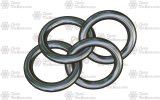
Band:
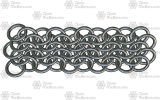
Josue:
Weave cell (also weave cell for Sense of Humor chain):
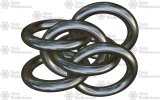
Weave cell alternate:
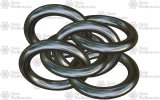
Band:

Half Persian 3 in 1 to Josue Unit:
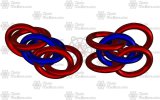
Sense of Humor (Parallel):
Weave cell:
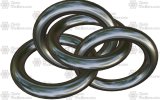
Band:

Sense of Humor (Staggered):
Weave cell:
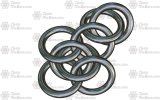
Band:
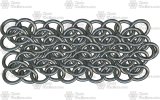
Cellular Chainmaille Theory - CCT
Cellular Chainmaille Theory (CCT for short) is something that we're working on here at chainmaillers.com. It is currently a work in progress. Cell types and forms used in this article are based upon our current findings. We hope to be able to share more information with you regarding CCT in the future.Author's note:
It is our intent that these articles be living documents where additional information, corrections to any errors, and improvements will be incorporated over time. We encourage any discussion, insights, suggestions, or corrective criticism you may have on the subject presented in this article. This can be done by clicking the "Join the Discussion" button.
If you found this article useful or informative, please leave a rating.
